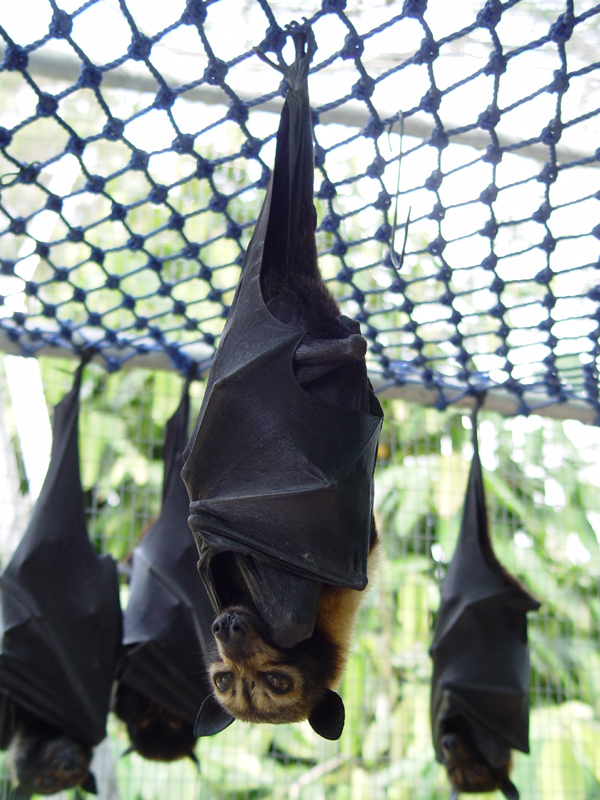- Spectacled Flying-fox
Taxobox
name = Spectacled Flying-fox

status = LR/lc | status_system = IUCN2.3
regnum =Animalia
phylum = Chordata
classis = Mammalia
ordo =Chiroptera
familia =Pteropodidae
genus = "Pteropus "
species = "P. conspicillatus"
binomial = "Pteropus conspicillatus"
binomial_authority = Gould, 1850The Spectacled Flying-fox, "Pteropus conspicillatus" also known as the Spectacled Fruit Bat, lives in Australia's north-eastern west regions of
Queensland . It is also found inNew Guinea and on the offshore islands includingWoodlark Island ,Alcester Island ,Kiriwina , andHalmahera .The Spectacled Flying-fox was listed as a threatened species under the Commonwealth Environment Protection and Biodiversity Conservation Act of 1999. They are considered vulnerable due to a significant decline in numbers as a result of loss of their prime feeding habitat and secluded camp sites.
Physical Characteristics
The head and body length is 22–25 cm, forearm 16–18 cm, weight 400–1000 g. A large black
flying fox has pale yellow or straw-colored fur around its eyes. The mantle is pale yellow and goes across the back, neck, and shoulders. Some have pale yellow fur on the face and top of the head.Habitat
Spectacled Flying-foxes are forest dwellers and rainforests are its preferred habitat. They prefer to roost in the middle and upper canopies of rainforest in the full sun. Colonies of the Spectacled Flying-fox can also be found in
mangrove s,paperbark andeucalypt forests. No colony is known to be found more than 7 km from a rainforest. It lives in the canopy and lives off of the various fruits that are found there.Diet
The Spectacled Flying-fox feeds at night on many different native species, for fruit, pollen and blossom; also a limited number of species for foliage. They will also feed on crops of mangoes, lichees and long-ons if farmers do not net their orchards. The foraging distance for these bats is up to 70km. As with many of the flying foxes, this species may drink seawater on the way to feeding sites.
Gallery
References
* Birt, P., Markus, N., Collins, L. & Hall, L. (1998) Nature Australia, Spring, pp. 55-59.
* Churchill, S. (1998) "Australian Bats," Reed New Holland, Sydney, pp. 84-85.
* Hall, L. (1983) Spectacled flying fox. In R. Strahan (ed.). "The Mammals of Australia," Reed Books, Chatswood, p. 282.External links
* [http://www.tolgabathospital.org/ Tolga Bat Hospital, Australia]
* [http://www.freesound.org/samplesViewSingle.php?id=57555 Recording of a colony of Spectacled Fruit Bats at Freesound]
Wikimedia Foundation. 2010.
